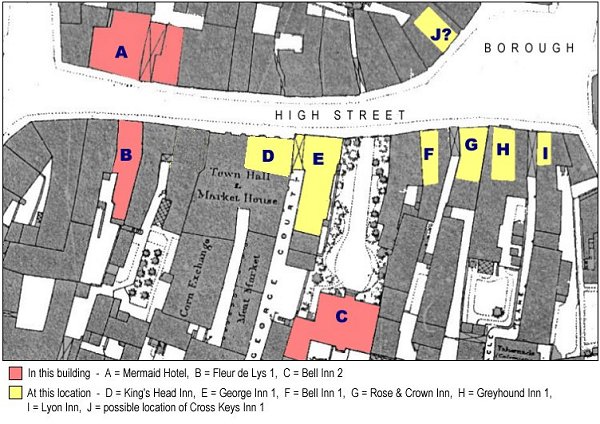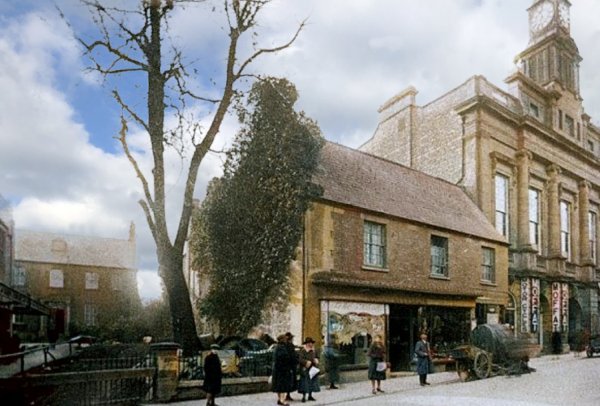the history of yeovil's pubs
PUBS HOME PAGE |
PUBS INTRODUCTION |
PUBS BY NAME |
BEERHOUSES |
bell inn (2)
High Street / The Borough
The second Bell Inn (marked as 'C' on the 1886 map below), described from here on, was originally an 18th century house but an advertisement in the Western Flying Post of 1753 shows it to have been an inn at this date. Whitmarsh's stagecoach left from the Bell Inn every Tuesday and reached London by Saturday, returning the following week.
The Bell Inn stood on the south side of the Borough set back somewhat from the road as seen on the map above and in the first photograph below. In fact it was located nearly halfway between High Street and South Street. It was a fine two-storey stone building with a porch supported by Corinthian columns.
The 1846 Tithe Apportionment notes that the Bell, as Parcel 235, was owned and occupied by Thomas Binford (although he actually lived in Clyst Honiton, Devon).
The 1886 Ordnance Survey map shows the building listed as the Borough Hotel although trade directories of the 1840's and 1850's, as well as the 1891 census, list it as the Bell Inn (see below). Having said that, the 1881 census shows it to have been the residence, and probably the medical practice, of Dr George Flower, later of Hendford.
It was purchased by Yeovil Corporation in 1898 to be used as the town’s first municipal offices, called Borough House, and was adapted for the Corporation's use at the cost of £100. The building served as a council chamber and offices until it was demolished in 1924 for the new development of King George Street.
map

gallery

This colourised photograph of about 1915 shows the former Bell Inn, at left, set well back from High Street. By the time of this photograph the building was called Borough House and was used as municipal offices. The tree and shop at centre are in the position of where King George Street now joins High Street and the tall building at right is the old Town Hall (built in 1849) with its tower and gas-illuminated clock, installed in 1912. The Town Hall was destroyed in 1935 by a fire believed to have been caused by paper rubbish blowing into the tower and ignited by the gas jets illuminating the clock.

This
colourised photograph
features in my
book 'Yeovil From Old Photographs'.
A photograph of the Bell Inn taken about 1880 showing the fine Corinthian columns supporting the porch and the bow-headed window above - a nice architectural touch.
owners / tenants / licensees
1736 – Widow (Annabella)
Rooks, late Ann
Bowditch
(Portreeve's
Account Book)
1745 – Widow
Rooks
(Portreeve's
Account Book)
1753 – Licensee
not named by
advertisement in
Western Flying
Post
1760 – Mr Lock
(Poor Rate Book)
Rent = 14
shillings per
annum
1764 – John Lock
(Conveyance of
1764)
1846 – Thomas Binford, owner/occupier (1846 Tithe Apportionment)
Documentation
|
1736-45 |
Wido.
Rookes,
late
Jane
Bowditch,
for the
Bell...
14s 0d.
(Portreeve's
Account
Book,
Rents
Received) |
|
1760 |
Mr
Lock
3½d.
(Poor
Rate
Book) |
|
1764 |
26 September 1754. Benjamin Dymond, innholder of Weymouth, to Edward Boucher the younger, gent of Yeovil - Dwellinghouse, etc., in High Street between tenement lately of Annabella Reeks, and now of John Lock called the Bell Inn, on west and tenement in possession of Ann Penny, widow, on east, lately in possession of Robert Helliar, then of Theodosia Helliar, widow, who intermarried with Benjamin Dymond and is since dead, and now in possession of Thomas Slade, apothecary. (Conveyance. SRO DD/PR W51/8.19 - Donn Papers) |
|
1857 |
About
this
time he
(the
Surveyor)
was also
instructed
to find
plans
for a
new Corn
Exchange
and
Market
to be
erected
on the
site of
the
out-premises
of the
Bell
Inn,
South
Street,
and the
old
vegetable
market.
(Goodchild
et al:
'The
Borough
of
Yeovil',
1954.
p72) |